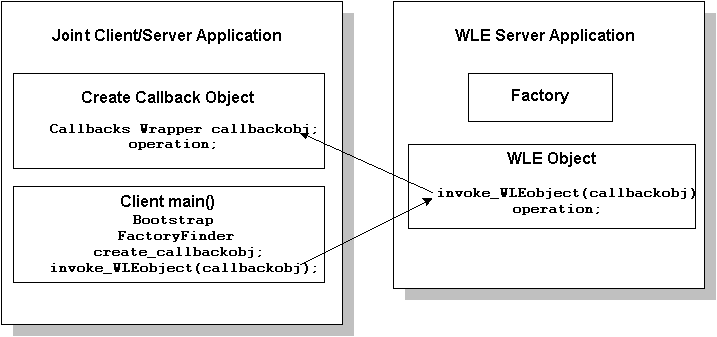


|

|
|
|
|
This chapter contains the following topics:
CORBA Server-to-server communication allows WebLogic Enterprise (WLE) applications to invoke CORBA objects and handle invocations from those CORBA objects (referred to as callback objects). The CORBA objects can be either inside or outside of a WLE domain.
The WLE product offers an implementation of the Internet Inter-ORB Protocol (IIOP) Version 1.2, which provides inbound and outbound communication with the CORBA objects. Server-to-server communication provides more efficient use of network resources and provides integration with third-party Object Request Brokers (ORBs). In addition, server-to-server communication is supported with CORBA objects that are implemented using IIOP versions 1.0 and 1.1.
In previous versions of the WLE product, client applications invoked operations defined in Object Management Group (OMG) Interface Definition Language (IDL) on a CORBA object. The server applications implemented the operations of the CORBA object. The CORBA objects in the server application used WLE TP Framework and environmental objects to implement state management, security, and transactions. These CORBA objects as referred to as WLE objects. Server applications could act as client applications for other server applications; however, client applications could not act as server applications for other client applications.
Server-to-server communication allows client applications to now act as server applications for requests from other client applications. In addition, server-to-server communication allows WLE server applications to invoke objects on other ORBs.
The server-to-server communication functionality is available through a callback object. A callback object has two purposes:
Overview of CORBA Server-to-Server Communication
Joint Client/Server Applications
Callback objects do not use the TP Framework and are not subject to WLE administration, they should be used when transactional behavior, security, reliability, and scalability are not important.
Callback objects are implemented in joint client/server applications. A joint client/server application consists of the following:
Figure 1-1 shows the structure of a joint client/server application.
C++ and Java joint client/server applications are supported.
Use of callback objects in Java applets is limited due to Java applet security mechanisms. Any Java applet run-time environment that allows a Java applet to create and listen on sockets (via the proprietary environment or protocol of the Java applet) can act as a joint client/server application. However, if the Java applet run-time environment restricts socket communication, the Java applet cannot act as a joint client/server application.
Note:
The ActiveX client software that is included in the WLE V4.2 kit does not support callback objects, and, therefore cannot be used to develop joint client/server applications.
Joint client/server applications use IIOP to communicate with the WLE server applications. IIOP can work in the following ways, depending on the version of the IIOP protocol you are using:
Figure 1-1 Structure of a Joint Client/Server Application

Joint client/server applications are always connected to the same IIOP Server Handler (ISH) in the WLE domain. That ISH reuses the same connection to send requests to and receive requests from the joint client/server application.
Joint client/server applications use the register_callback_port method of the Bootstrap object to register the listening port of the joint client/server application in the ISH. Invocations from server applications on the callback object in the joint client/server application are routed through the ISH connected to the joint client/server application. This ISH uses a second outbound connection to send requests to and receive replies from the connected joint client/server application. The outbound connection is paired with the incoming connection. This differs from bidirectional IIOP, which uses only one connection.
Joint client/server applications can invoke on any callback object, and are not restricted to invoking callback objects implemented in joint client/server applications connected to an ISH. Asymmetric IIOP forces the ORB infrastructure to search for an available ISH to handle the invocation.
For a more detailed description of bidirectional, dual-paired connnection, and asymmetric IIOP, see the C++ Programming Reference Callback objects are assigned policies that control how long an object reference is valid and how an object ID is assigned to the object. Object policies are defined when the reference to the callback object is created. In addition, they can be defined in the Callbacks Wrapper object, which simplifies the development of joint client/server applications.
The following object policies are supported for callback objects:
Object Policies for Callback Objects
When creating a callback object with an object policy of transient, the object reference is valid only until the joint client/server application is terminated or until the stop_all_objects
method is called.
When creating a callback object with an object policy of persistent, the object reference is valid even after the termination of the joint client/server application. If the joint client/server application terminates, restarts, and activates a servant for the same object ID, the servant accepts requests made on that object reference.
Note:
If you are creating a native joint client/server application (that is, a joint client/server application that is located in the same WLE domain as the WLE server applications that invokes it), you cannot use the Persistent/System ID or Persistent/User ID object policies.

|
|
|
Copyright © 1999 BEA Systems, Inc. All rights reserved.
|